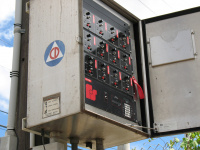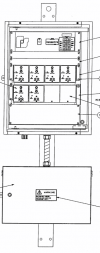MC
| MC | |
[[File: |200px]] |200px]] An MC6024 in Hawaii. | |
| Produced | 1989?-1995? |
|---|---|
| Type | Electronic Siren Controller |
| Preceded by | SiraTone |
| Succeeded by | MCP |
The MC, or Modulator Controller, was an electronic siren controller produced by Federal Signal Corporation for the Modulator, DSA, and EOWS series of sirens.
Operation
The MC was a new design of controller by Federal Signal, with the only similarities between it and its predecessor, the SiraTone, being the amplifiers used and the capability to run the EOWS*612 rotating speaker array. The controller was a microprocessor operated platform which used digital, solid state systems to produce the 7 signals provided by Federal Signal. Unlike the SiraTone, the MC had tones pre-loaded onto an audio ROM chip so there was no need for an analogue tone generator and timer circuit. Audio from the ROM chip was programmed by Federal Signal. The auxiliary tone was Westminster Chimes by default unless a different tone was requested for by the customer. The MC also came with digital voice messages, zones (for the EOWS*612) and had a status report function as well.
The system was activated by two-tone or by DTMF by the controller's internal radio, locally by keying in a two digit code on the controller's keypad, or by operating the controller via landline. When using two-tone or DTMF, the siren has to be "armed" in order to operate (unless programmed not to). To do this a DTMF arm string would first be broadcast to the controller, then a signal DTMF string would be broadcast. Arm period would last for 5 minutes until automatic disarm, unless a "disarm" DTMF string was broadcast before the time expired. This is different, and more secure, to the SiraTone which required a jumper to be added in order to permanently arm the controller. After a signal was activated the digital audio was sent through a digital/analogue converter to each amplifier and onto the speaker array.
Construction
The MC was constructed inside a a NEMA 4 enclosure with the batteries inside a vented NEMA 4 enclosure. These new enclosures had built in locks and clamps which increased security. A typical fully constructed MC3012 controller would weigh 190 pounds (45 kilograms). The controller came in two sizes. There is a small, MCP style enclosure for the MC1004 and 2008 and there is the larger and more common controller size for the MC3012-MC6024. The MC1004, 2008, 3012 and 4016 run off two batteries whereas the MC5020 and 6024 run off 4 batteries to allow larger current draw. All models came with PA function on the controller and were able to have a remote PA function as well. The controller came in 3 different metal grades: stainless steel, aluminium and painted steel.


The internals of the controller are rack mounted with four or two screws at opposite ends, much like how network gear is mounted to a network rack. This rack mounting assembly hinges out so the engineer can easily access the DIN rails behind and make all the necessary connections such as wiring up the service power to the charger etc. This is a difference to the SiraTone which has the separate modules slide out on rails and is also a design improvement as it makes the controller more modular. For example, the MC6024 controller shown at the top of the page has the control interface mounted at the bottom rather than the top of the panel, making it easier for servicing. Once power is applied by the batteries the controller's internal clock starts running and programming can commence.
The MC uses the same amplifiers to the SiraTone which allows backwards compatibility between the two controllers. Each amplifier is connected to a module backplane. Each module consists of two amplifiers. On each module backplane there is a jumper which sets the tone the module will play: high or low, which corresponds to signal A or signal B. Rotation circuitry is also provided for in the MC3012 only to support using the EOWS*612, which was being manufactured along with the Modulator and DSA. The controller is operated by a 24 character keypad and display.